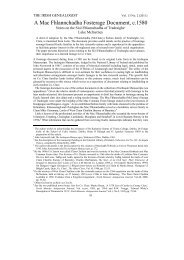Report Cover Vol I - Clare County Library
Report Cover Vol I - Clare County Library
Report Cover Vol I - Clare County Library
Create successful ePaper yourself
Turn your PDF publications into a flip-book with our unique Google optimized e-Paper software.
The <strong>County</strong> <strong>Clare</strong> Wetlands Survey Patrick Crushell & Peter Foss 2008<br />
____________________________________________________________________________________<br />
7 Results<br />
7.1 CWS Data Limitations<br />
A number of difficulties and limitations with respect to the compilation of the CWS list of wetland sites<br />
were encountered, which the reader should be aware of, before interpretation of the data is undertaken<br />
and to provide an estimate of the level of confidence that can be applied to the data from the current<br />
study.<br />
7.1.1 Wetland site identification<br />
Although every effort was made to compile a complete map of all wetland sites in <strong>County</strong> <strong>Clare</strong>, from an<br />
examination of aerial photographs, and from data held by external sources, it is very probable that<br />
additional smaller wetland sites do occur which have not been mapped within the CWS GIS and database.<br />
Therefore the list of sites presented here should not be regarded as definitive.<br />
Primarily this lack of site identification is due to: the small nature of some wetland types making mapping<br />
impractical (e.g. drains); it was not possible to include all areas of common habitat type such as wet<br />
grassland, which may occur in a mosaic within other habitats including improved grassland; the<br />
occurrence of wetland areas that cannot be identified from aerial photographs; and because detailed<br />
habitat maps do not exist for certain areas identified as being of conservation value.<br />
7.1.2 Wetland habitat type classification<br />
During the selection of wetland sites, it was not always possible to ascertain with complete certainty,<br />
which of the wetland types recognised by this survey, occurred on a given site.<br />
In other cases, where more than one wetland type occurred within a site, in a complex mosaic of<br />
habitats, the habitat was recorded as ‘CWS Unknown Wetland Type’. To ascertain the level 3 Fossitt<br />
category (or even level 1 in the case of wet grassland, reed-swamp, marsh or fen) present on these sites<br />
ground truthing via field surveys will be required.<br />
The data-sets which contributed to the habitat map came from a variety of sources (as recorded within<br />
GIS). This has meant that it is of varying quality, much of it originates from detailed field surveys while<br />
other data may originate from Satellite Imagery (in the case of degraded raised bog from Corine<br />
dataset). Therefore, it must be emphasised that the habitat map should be treated with care and used<br />
only as an indicative map of habitat distribution.<br />
7.1.3 Estimation of the extent of wetland habitats on sites identified<br />
Where a detailed GIS habitat map existed, with wetland habitats mapped and characterised to Fossitt<br />
level 3, the information was incorporated into this study, and the area data was used in final estimation<br />
of level 3 Fossitt habitat extent within <strong>County</strong> <strong>Clare</strong>. The habitat extent data covers the entire county<br />
(with patchy distribution) and although somewhat biased towards previously recorded sites was not<br />
restricted to these areas.<br />
In the case where wetland habitats could only be characterised to Fossitt level 1 or 2, the area data was<br />
used to this level only.<br />
As a result of these limitations the area data results provided here should be regarded as provisional.<br />
Only with future surveys and ground truthing by experienced ecologists will level 3 habitat identification<br />
be possible. It is envisaged that the habitat map is a ‘work in progress’ and should improve as new data<br />
becomes available. The calculated habitat area data are a useful guide towards the relative abundance of<br />
different habitat types in the county and we believe provide a good indication of minimum area estimates<br />
for each habitat type.<br />
46
















